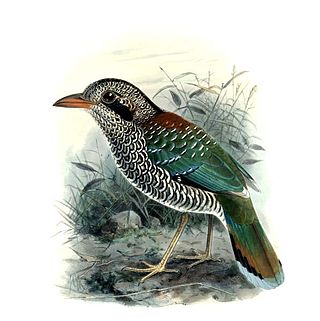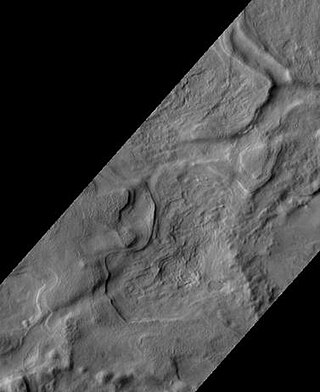
The family Gryllidae contains the subfamilies and genera which entomologists now term true crickets. Having long, whip-like antennae, they belong to the Orthopteran suborder Ensifera, which has been greatly reduced in the last 100 years : taxa such as the spider-crickets and allies, sword-tail crickets, wood or ground crickets and scaly crickets have been elevated to family level. The type genus is Gryllus and the first use of the family name "Gryllidae" was by Francis Walker.

Galium boreale or northern bedstraw is a perennial plant species of the Rubiaceae family. It is widespread over the temperate and subarctic regions of Europe, Asia and North America including most of Canada and the northern United States.

The scaly ground roller is a species of bird in a monotypic genus in the near-passerine family Brachypteraciidae. It is endemic to eastern Madagascar. Its natural habitat is subtropical or tropical moist lowland forest. The scaly ground roller is found at elevations below 1,000 meters (3,300 ft), and one of the few birds of Madagascar to reside in lowland rainforest.

Cycloptilum is a genus of common scaly crickets in the family Mogoplistidae from the Americas. There are at least 50 described species in Cycloptilum.

Chasma Boreale is a large canyon in Mars's north polar ice cap in the Mare Boreum quadrangle of Mars at 83° north latitude and 47.1° west longitude. It is about 560 km (350 mi) long and was named after a classical albedo feature name. The canyon's sides reveal layered features within the ice cap that result from seasonal melting and deposition of ice, together with dust deposits from Martian dust storms. Information about the past climate of Mars may eventually be revealed in these layers, just as tree ring patterns and ice core data do on Earth. Both polar caps also display grooved features, probably caused by wind flow patterns. The grooves are also influenced by the amount of dust. The more dust, the darker the surface. The darker the surface, the more melting as dark surfaces absorb more energy.

Mogoplistidae is a family of scaly crickets within the superfamily Grylloidea. Considered to be monophyletic, a sister taxon to the Gryllidae crickets. This family consists of more than 370 species worldwide; 20 species in 4 genera occur in North America and this family includes the scaly crickets of Europe.

Grylloidea is the superfamily of insects, in the order Orthoptera, known as crickets. It includes the "true crickets", scaly crickets, wood crickets and other families, some only known from fossils.

Hypericum boreale, also known as northern St. John's-wort, is a short-lived perennial species of flowering plant in the family Hypericaceae, section Trigynobrathys.

Gryllidea is an infraorder that includes crickets and similar insects in the order Orthoptera. There are two superfamilies, and more than 6,000 described species in Gryllidea.
Cycloptilum slossoni, or Slosson's scaly cricket, is a species of scaly cricket in the family Mogoplistidae. It is found in North America.
Hoplosphyrum is a genus of scaly crickets in the family Mogoplistidae. There are about six described species in Hoplosphyrum, from Africa and the Americas
Cycloptilum comprehendens, the syncopated scaly cricket, is a species of scaly cricket in the family Mogoplistidae. It is found in North America.
Echmepteryx madagascariensis is a species of scaly-winged barklouse in the family Lepidopsocidae. It is found in Africa, Australia, the Caribbean Sea, Europe and Northern Asia, Central America, North America, Oceania, South America, and Southern Asia.

Anthidiellum notatum, the northern rotund resin bee, is a species of bee in the family Megachilidae. It is found in North America.

Anthidiellum is a genus of rotund resin bees in the family Megachilidae. There are more than 60 described species in Anthidiellum.
Echmepteryx intermedia is a species of scaly-winged barklouse in the family Lepidopsocidae. It is found in the Caribbean Sea, Central America, and North America.

Cycloptilum trigonipalpum, the forest scaly cricket, is a species of scaly cricket in the family Mogoplistidae. It is found in North America.
Cycloptilum bidens, the two-toothed scaly cricket, is a species of scaly cricket in the family Mogoplistidae. It is found in North America.
Cycloptilum squamosum, known generally as the Scudder's scaly cricket or Scudder's scaly bush cricket, is a species of scaly cricket in the family Mogoplistidae. It is found in North America.
Karim Vahed FRES is a British entomologist. He is a professor of entomology and England manager at invertebrate conservation charity Buglife, and is an expert in crickets and bushcrickets (katydids).











